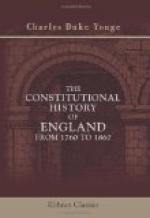Notes:
[Footnote 172: Against Junot, at Vimiera and Rolica, in 1808; Soult, at Oporto, and Victor, at Talavera, in 1809; Massena and Ney, at Busaco and Torres Vedras, in 1810; Massena and Bessieres, at Fuentes d’Onor, in 1811. Ciudad Rodrigo and Badajoz had been taken in 1812, in spite of the neighborhood of Soult and Marmont. In July, 1813, a month after the formation of Lord Liverpool’s ministry, he routed Marmont at Salamanca; in 1813 he took Madrid, and routed Jourdain at Vittoria; and, having subsequently defeated Soult at Sauroren, he crossed the French frontier in October.]
[Footnote 173: A resolution, moved by Mr. Canning, to take the claims of the Roman Catholics into consideration in the next session had been carried in June by the large majority of 129; and when Lord Wellesley brought forward a similar motion in the House of Lords, not only did Lord Liverpool “protest against its being inferred from any declaration of his that it was, or ever had been, his opinion that under no circumstances would it be possible to make any alteration in the laws respecting the Roman Catholics,” but the Chancellor, Lord Eldon, who was generally regarded as the stoutest champion of the existing law, rested his opposition entirely on political grounds, explaining carefully that he opposed the motion, “not because he quarrelled with the religion of the Roman Catholics, but because their religious opinions operated on their political principles in such a way as to render it necessary to adopt some defence against them,” and met the motion by moving the previous question, avowedly because “he did not wish, at once and forever, to shut the door of conciliation;” and the previous question was only carried by a single vote—126 to 125.]
[Footnote 174: “It (difference on the Catholic question) was an evil submitted to by the government, of which Mr. Fox, Lord Grenville, and Lord Grey were members, in the years 1806, 1807, as well as by the governments of Mr. Perceval, Lord Liverpool, and the Duke of Wellington.”—Peel’s Memoirs, i., 62. This passage would seem to imply that Peel believed the Catholic question to have been left “open” in 1806; but there is not, so far as the present writer is aware, any trace of such an arrangement on record, and Lord Liverpool’s letter to the King, of November 10, 1826 ("Life,” iii., 436), shows clearly that he was not aware of such a precedent for the arrangement which, in 1812, “he and others advised his Majesty” to consent to. Moreover, the condemnation passed on it by Mr. Ponsonby, who had been Chancellor of Ireland in 1806 and 1807, seems a clear proof that he knew nothing of it, though it is hardly possible that he should have been ignorant of it if it had existed.]




